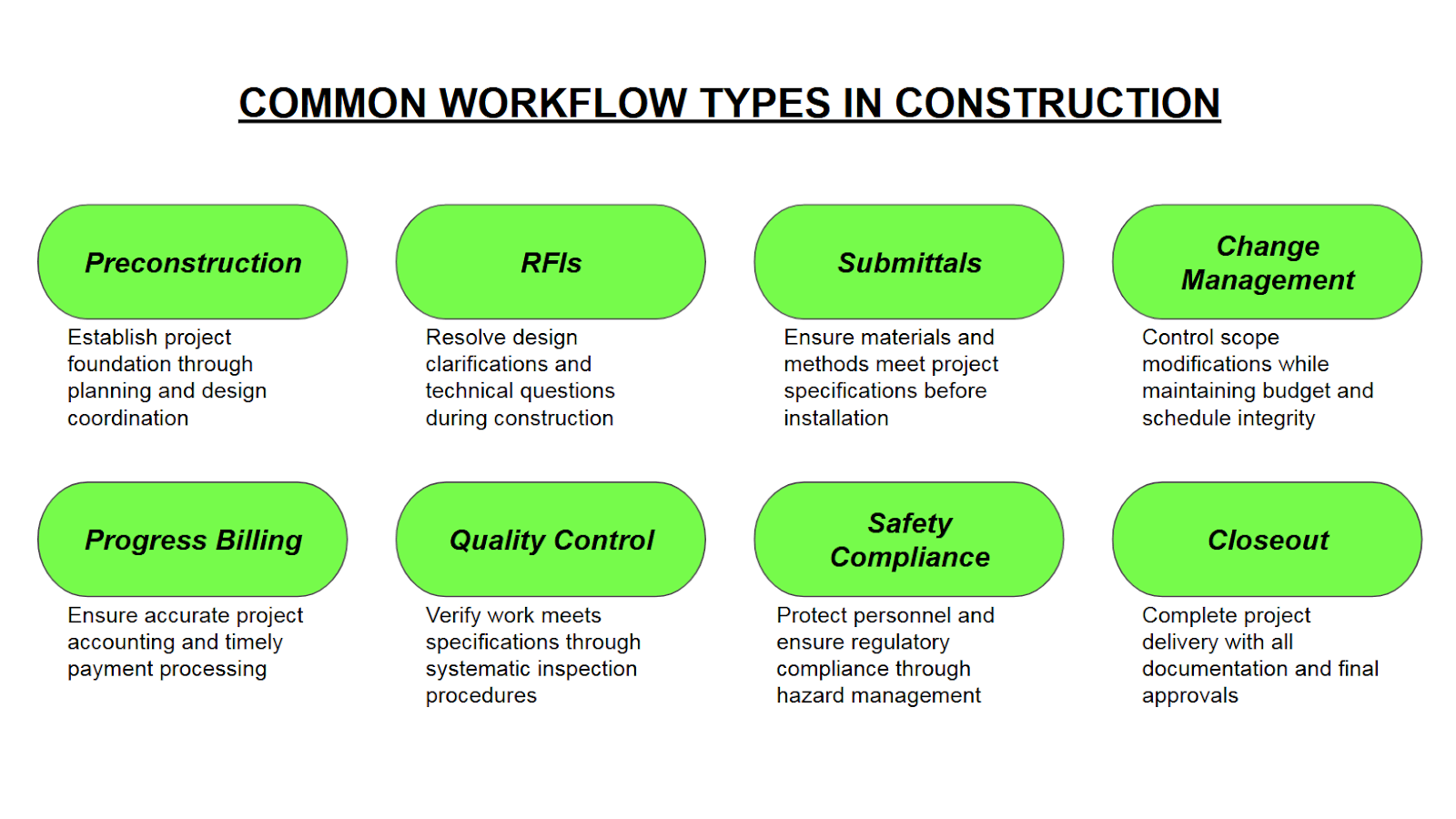How to Get More Done with Better Construction Workflows
- What is a construction workflow?
- What are the common time-wasting pitfalls in construction workflows?
- How does technology streamline construction workflows?
- What best practices can improve the efficiency of construction workflows?
- What are the most common types of workflow in construction?
- How can the success of construction workflow management be measured?
- What are the future trends in construction workflow management?
- How can Revizto improve construction workflow efficiency?
- Key takeaways
- Frequently asked questions

What is a construction workflow?
A construction workflow is a sequence of tasks, communications, and decision-making processes that guide projects from initial planning to the final steps of completion. In contrast with traditional project management, which relied on rigid hierarchies and periodic check-ins, construction workflow management uses real-time coordination to its fullest, with continuous information flow and adaptive responses to field conditions.
This approach turns construction from a series of disconnected actions into a seamless and integrated process where every stakeholder (architects, engineers, subcontractors, suppliers, etc.) works with synchronized timing and shared visibility.
What are the core components of an effective workflow?
Effective construction workflows consist of five essential components that operate in tandem to eliminate bottlenecks, maintaining project momentum as a result:
- Communication channels form the foundation of an effective workflow, ensuring real-time information sharing between field personnel and office teams using digital platforms and mobile connectivity
- Documentation systems generate a single source of truth for drawings, specifications, changes, and approvals to prevent costly miscommunications or rework
- Resource coordination manages material, equipment, and labor flow to ensure the correct location, timing, and resource type for every delivery
- Quality checkpoints are positioned throughout the workflow in order to catch issues before they cascade into bigger problems
- Progress tracking mechanisms offer continuous visibility into project status, enabling proactive adjustments rather than reactive crisis management
These components must be integrated seamlessly, because if even one fails, the entire workflow may collapse into cost overruns and delays.
How does workflow management differ from traditional project management?
Construction workflow management operates as a continuous, adaptive system, not a linear sequence of predetermined phases. Traditional project management usually follows a waterfall approach, with each phase being completed before the next begins. This approach means limited flexibility for any changes or concurrent activities. Workflow management, on the other hand, provides parallel processing and real-time adjustments based on emerging requirements and field conditions, which makes it much more flexible.
While traditional methods rely strongly on scheduled meetings and formal documentation to share progress details, workflow management uses mobile technology and digital tools to grant instant updates and immediate problem resolution. The use of shared platforms and integrated processes also makes it possible for workflow management to break down the various information silos between different trades or project phases. The overall shift from periodic oversight to continuous coordination significantly reduces total response times while preventing small issues from becoming significant setbacks, as well.
Why is workflow management crucial for the construction industry?
Construction projects face unique challenges that make workflow management invaluable for success. The biggest issues in construction projects include dynamic site conditions, multiple stakeholders with competing priorities, and tight deadlines with substantial financial penalties for delays. The fragmented nature of the industry creates countless opportunities for miscommunication and failures in coordination.
Effective workflow management directly addresses these issues by creating structured processes capable of maintaining project momentum despite the inevitable disruptions. Construction projects with optimized workflows are consistently better at project completion with fewer change orders compared with traditionally managed projects. In an industry where a single day’s delay costs a lot of money and affects multiple trades, workflow management is an economic necessity rather than an optional approach with notable benefits.
What are the common time-wasting pitfalls in construction workflows?
Despite the best intentions and detailed planning, construction projects consistently fall victim to predictable workflow disruptions that waste time, inflate budgets, and frustrate team members.
Understanding the nature of these common pitfalls is an important step toward creating more resilient processes capable of adapting to challenges instead of being disrupted by them:
| Common workflow issue | Effective resolution |
| Communication breakdowns between trades | Real-time messaging platforms and mobile connectivity |
| Multiple document versions causing confusion | Cloud-based version control systems |
| Material delivery coordination failures | Automated scheduling and tracking systems |
| Delayed decision-making on RFIs (requests for information) | Digital approval workflows with notifications |
| Resource allocation conflicts | Integrated resource management platforms |
| Late discovery of quality issues | Embedded inspection checkpoints |
| Change order processing delays | Streamlined digital approval processes |
| Field teams working from outdated plans | Mobile access to current documentation |
How do communication breakdowns affect project timelines?
Communication failures create cascading delays that extend project timelines by weeks or even months depending on the severity. When field teams cannot reach project managers for urgent decisions, work stops completely while crews wait for clarification. Similarly, when design changes are not communicated properly to all trades, subcontractors continue their work using outdated plans, creating highly expensive rework scenarios.
The most damaging communication breakdowns happen during critical handoffs between trades, such as when electrical teams are not notified that plumbing plans are complete, or when concrete pours start without final approval from the structural engineering team. These gaps force projects into reactive mode, where teams often scramble to coordinate activities that should flow seamlessly. Mobile connectivity issues, outdated lists of contacts, and overreliance on informal verbal instructions compound these issues, forming an environment where important information is regularly lost or delayed.
How does poor documentation management create costly delays?
Inadequate documentation systems force teams to waste hours searching for up-to-date drawings, specifications, and approval records instead of doing more productive work. When multiple versions of plans circulate in the system without clear version control, trades often work with conflicting information, which leads to installation errors that are very expensive to resolve.
Missing or incomplete documentation creates even more serious issues during inspections and client approvals. Projects stop practically any work when inspectors cannot find the required certificates, test results, or compliance documentation. Each change order in this context becomes extremely challenging if teams cannot locate the original scope documents or histories of approvals. Paper-based systems, scattered digital files, and inconsistent naming conventions turn simple document retrieval processes into time-consuming detective work, delaying decision-making and slowing project momentum.
How can poor resource allocation lead to wasted time?
Inefficient resource planning efforts cause delays and raise costs, with crews arriving on-site only to discover that equipment is unavailable, materials are missing, or there are conflicts in scheduling. When concrete trucks arrive before forms are ready, or when specialized equipment sits idle because operators are assigned to different projects, productivity is extremely low while labor costs skyrocket.
The consequences of poor resource management extend beyond immediate delays, as well, as poorly coordinated deliverables force materials to be stored for longer time periods than planned (increasing the risk of theft or damage). Overstaffing certain phases while understaffing others is also relatively common, creating periods of expensive downtime that are always followed by rushed work with reduced quality.
A lack of real-time visibility into resource availability, inadequate buffer planning for weather delays, and failure to coordinate delivery schedules turn resource management into an ongoing challenge of countering new and upcoming issues instead of being a smooth and coordinated operational process.
How does technology streamline construction workflows?
The digital transformation has fundamentally changed how successful construction projects operate, moving from paper-based and fragmented processes to integrated systems that offer real-time visibility and seamless coordination throughout all project phases.
How do digital project management platforms improve workflow efficiency?
Digital project management platforms eliminate bottlenecks in workflows by creating a single, accessible hub for all project information to be stored and updated in real-time. These systems replace paper documents, email chains, and scattered spreadsheets with centralized dashboards capable of tracking progress, managing tasks, and coordinating schedules across multiple trades at the same time.
The most significant efficiency gains come from automated workflow triggers that move projects forward without the need for any manual intervention. When an inspector approves an electrical rough-in, the platform can notify the drywall contractor automatically, along with introducing updates to the master schedule. The ability for change orders to flow through digital approval chains helps maintain complete audit trails while accelerating decision-making processes.
Integration capabilities allow these platforms to connect with supply chain management tools, accounting systems, and field data connection apps to create a seamless information ecosystem. Instead of re-entering data multiple times across different systems, teams only have to input information once and wait for it to populate throughout all connected processes for dramatically reduced administrative overhead.
How does mobile technology enhance on-site communication?
Mobile technology transforms construction sites into connected environments where field teams have instant access to critical information and can communicate updates without leaving their work locations. Superintendents use tablets to pull up current drawings, submit daily reports, and photograph progress documentation on site.
Real-time messaging capabilities allow for immediate problem resolution that prevents expensive delays. When a plumber discovers a conflict with existing utilities, they have the ability to instantly message the project engineer, attach photos of the issue, and receive revised installation instructions within minutes, rather than waiting for hours until office personnel visit the construction site.
Mobile apps also streamline quality control and safety processes by allowing workers to complete checklists, document inspections, and report incidents directly from their smart devices. Immediate data capture capabilities ensure that nothing gets forgotten or misrecorded, while GPS tagging and timestamp features grant accurate location and timing information for all field activities.
What role does automation play in streamlining construction processes?
Automation eliminates repetitive manual tasks that consume valuable time and introduce human error into construction workflows. Automated scheduling systems continuously optimize work sequences based on weather forecasts, resource availability, and completion dependencies, instantly adjusting timelines when conditions change.
Document management automation ensures that the right information reaches the right people at the right time without manual intervention. When architects issue drawing revisions, automated systems immediately distribute updates to the contractors affected, flag potential conflicts with existing work, and update material takeoff quantities.
Financial process automation accelerates project cash flow by automatically generating progress billing, processing change orders, and tracking cost overruns against the baseline budget. These systems flag potential issues before they become real problems, such as alerting project managers when material costs approach budget thresholds or if labor hours exceed projections for specific phases.
What best practices can improve the efficiency of construction workflows?
Successful construction workflow management requires the implementation of proven best practices that address the most common sources of inefficiency and delay. While technology provides powerful tools, the foundation of effective workflows lies in establishing consistent processes, clear accountability, and continuous improvement mindsets for all project phases.
These practices work in synergy – implementing one improves the effectiveness of others, creating a compound effect to dramatically improve project outcomes. The following best practices are the most impactful changes construction teams have access to for workflow efficiency optimization.
Standardize workflow processes
Create consistent, repeatable procedures for all routine activities from project kickoff through final closeout. Standardization eliminates confusion about who is supposed to do what, when, and how while ensuring that no critical steps are skipped. It is important to document these processes clearly and teach all team members to follow them consistently. When everyone follows the same procedures for change orders, submittals, and quality checks, projects flow smoothly without the need for constant decision-making about basic operational details.
Use visual planning tools (e.g., Gantt charts, Kanban)
Visual planning tools make complex project schedules immediately understandable to all stakeholders regardless of their technical background. Gantt charts reveal dependencies and critical paths, while Kanban boards are used to see work status at a glance. These tools are immensely helpful when it comes to identifying various bottlenecks before they cause issues, ensuring that everyone understands how their work affects other teams and tasks. Visual scheduling also simplifies the process of communicating changes or adjustments to clients and subcontractors.
Invest in training and upskilling your team
Well-trained teams often have better efficiency in terms of workflow execution, and they are less likely to make costly mistakes. Regular training on new technologies, safety procedures, and project management techniques pays off in the form of faster task completion and reduced rework. Cross-training team members also provides a degree of flexibility when key personnel are unavailable or schedules change unexpectedly. Additionally, investment in skills development tends to improve employee retention, positively affecting the various disruptions and costs associated with high turnover rates.
Conduct regular progress reviews and adjust accordingly
Scheduling frequent check-ins to assess workflow performance and make adjustments when necessary is highly recommended for any organization. Weekly progress reviews must keep an eye on resource utilization, schedule adherence, and emerging challenges. These meetings may also be used to celebrate successes, address concerns, and refine existing processes using real project experience. Proactive adjustments help prevent the gradual degradation of workflow as project conditions continue to change in accordance with industry requirements and competitive demands.
Establish clear roles and responsibilities
It is essential to define responsibilities for every single component of workflow in order to eliminate confusion and prevent tasks from being missed or forgotten. Decision-making authority, communication protocols, and escalation procedures must be documented. Coordination processes become significantly less challenging when every employee is aware of their responsibilities and understands how their role is connected to others. Clear accountability also allows for much faster problem resolution, since team members always know exactly who they must contact for each specific type of issue.
Integrate field and office operations seamlessly
Communication silos between field crews and office personnel must be broken down by establishing regular communication rhythms and shared information systems. Office personnel need clear visibility into actual field conditions and progress, while field teams require direct access to project documents, along with the ability to provide real-time updates. This integration prevents the disconnect that brings scheduling conflicts and issues with resource allocation.
Track KPIs and use data for continuous improvement
Key performance indicators (KPIs) must be carefully monitored to identify opportunities for workflow improvement. Schedule adherence, budget variance, and quality metrics are just a few examples of KPIs used to refine processes and adjust resource allocation when high-performance practices are recognized. Regular data analysis can reveal patterns that are not obvious during day-to-day operations, enabling evidence-based decisions about workflow optimization (instead of relying on nothing but intuition).
What are the most common types of workflow in construction?
Construction projects involve numerous interconnected workflows that need to operate smoothly to ensure success in project delivery. Knowing the difference between these workflows helps teams anticipate potential requirements and prepare appropriate documentation beforehand, coordinating activities effectively throughout all phases of the project.
Each workflow has its own triggers, participant requirements, and expected outcomes, which have a direct impact on project quality and timelines. These standard processes allow construction teams to respond quickly to routine situations while also maintaining focus on unconventional project challenges that necessitate creative problem-solving.

Preconstruction
Preconstruction workflows establish the foundation for successful project execution with the help of comprehensive planning, design coordination, and resource preparation. This phase includes subcontractor selection, permit acquisition, material procurement planning, and detailed scheduling. Teams conduct constructability reviews, finalize design specifications, and form communication protocols. Effective preconstruction workflows help avoid costly changes during construction by being able to identify and resolve potential conflicts or design issues before any work is initiated on site.
Requests for information (RFIs)
RFI workflows provide structured processes for resolving the design clarifications and technical questions that arise during construction. A typical RFI resolution process includes:
- Field teams submitting detailed questions with supporting documentation
- Project managers reviewing and routing requests to the appropriate design professionals
- Responses getting distributed to all relevant parties
Well-managed RFI workflows include tracking systems that monitor response times, maintain full records, and also ensure the timely resolution of any issue in order to avoid work stoppages as much as possible.
Submittals
Submittal workflows ensure that materials, equipment, and installation methods all meet the project specification before work continues. Contractors prepare detailed submissions including product data, shop drawings, and samples for design team review. The workflow consists of review periods, revision cycles, and final approvals with clear documentation. Proper submittal management helps avoid delays by securing approvals early on while ensuring that all parties have a complete understanding of any installation requirements or approved products.
Change management
Change management workflows control modifications to project scope while maintaining the integrity of budgets and schedules. The process begins with the identification of changes, includes detailed analysis of cost and schedule impacts, and needs formal approval before implementation. Effective change management workflows help prevent scope creep while maintaining clear accountability for project modifications. It is achieved by documenting the complete history of changes, tracking cumulative impacts, and ensuring that all stakeholders are aware of how changes affect their work.
Progress billing and payment processing
Financial workflows ensure the accuracy of project accounting with timely payment processing throughout different construction phases. These processes are progress measurement, invoice preparation, approval workflows, and payment disbursement. Effective financial workflows provide detailed cost tracking, monitor budget performance, and generate clear documentation for auditing purposes. Regular financial reporting operations keep all stakeholders in the loop when it comes to the financial health of the project and cash flow requirements.
Quality control inspections
Quality control workflows ensure that work meets all the specifications and industry standards through systematic inspection and testing procedures. These processes include:
- Inspection scheduling
- Deficiency identification
- Correction tracking
- Final acceptance
Quality workflows involve multiple parties including contractors, inspectors, and design professionals who have to work together to maintain project standards. Proper documentation serves as proof of compliance with specifications while also offering convenient records for maintenance or warranty purposes.
Safety compliance and reporting
Safety workflows protect personnel and ensure regulatory compliance using systematic hazard identification, training, and incident management. These workflows include tracking corrective actions, documentation requirements, and obligations about regulatory reporting. Daily safety inspections and incident reporting procedures create a culture of safety awareness, which is important for achieving the overarching goal. Effective safety management is responsible for preventing accidents while maintaining productivity and protecting all of the project’s stakeholders.
Closeout
Closeout workflows ensure the completeness of project delivery with all required documentation, testing, and owner training processes being completed. This phase covers final inspections, warranty documentation, as-built drawing preparation, and system commissioning. Effective closeout workflows prevent delays in terms of occupancy permits while ensuring that owners receive full project documentation. They also serve as protective measures for contractors when it comes to potential future liability, as well.
How can the success of construction workflow management be measured?
Effective workflow management requires systematic measurement in order to identify improvements, justify investments, and maintain continuous optimization. A lack of clear metrics and measuring capabilities means that teams work blindly, without the ability to distinguish between perception and reality when evaluating workflow performance. The goal of this process is not only data collection but also the transformation of data into actionable insights capable of driving meaningful improvements in project delivery and team satisfaction.
What key performance indicators (KPIs) should be tracked in construction workflows?
The most valuable workflow KPIs focus on time, cost, quality, and communication effectiveness across all project phases. Essential metrics include:
- Adherence to schedule – percentage of milestones that are met on time (tracked using project management software)
- Cycle time tracking – duration from the submission of an RFI to its resolution, or submittal approval times (tracked using digital timestamps on every submission)
- Cost performance – budget variance, resource utilization rates, rework percentages (pulled directly from accounting systems)
- Quality indicators – inspection pass rates, punch list quantities, client satisfaction scores (tracked and measured on a weekly basis)
- Communication metrics – response times, meeting effectiveness, information accessibility (acquired on a monthly basis using survey teams)
Leading indicators provide early warning signals about potential issues. Trending metrics like an increase in RFI volumes or lengthening submittal revision cycles might suggest that workflows need to be adjusted before a major issue arises. These predictive measurements help create a system of proactive management rather than significantly less efficient reactive problem-solving.
How can teams establish baseline measurements for workflow performance?
Establishing a reliable baseline requires collecting consistent data from multiple recent projects in order to understand normal performance ranges. Most businesses use 3-5 recent similar projects as the baseline, gathering historical data on key processes like permit approval times, material delivery schedules, and inspection cycles to create realistic performance benchmarks reflecting actual capabilities.
Industry benchmarking provides external context for such measurements by comparing the company’s performance against similar projects or average regional standards. Professional associations and industry publications often offer benchmark data to help teams understand whether their current performance is above, on par with, or below the average. This external perspective helps teams avoid sticking with poor system performance simply because it remains consistent with the company’s own historical experience.
How can feedback loops improve ongoing processes?
Effective feedback loops create continuous learning cycles to capture the lessons learned during project execution, and the insights acquired can immediately be applied to ongoing workflows. Simple tools like weekly digital surveys, monthly team huddles, and end-of-phase retrospectives are great at systematically gathering input from field teams about process bottlenecks, gaps in communication, or resource conflicts as they occur.
Structured feedback collection includes regular surveys, focus groups, and cross-functional sessions, bringing different trades together to share perspectives on workflow effectiveness. Implementation tracking ensures that feedback drives process improvements instead of just generating reports. All changes made based on such feedback must be documented, monitored, and refined based on ongoing performance data.
What methods help calculate the ROI on workflow improvements?
Calculating the return on investment (ROI) requires comparing measurable benefits against implementation costs over an appropriate time period. Time savings translate directly into labor cost reductions, while error prevention reduces the number of schedule delays and rework expenses. Improved communication workflows reduce coordination costs, preventing expensive misunderstandings that lead to change orders and even project disruptions.
Comprehensive ROI analysis is a combination of both hard and soft benefits to justify workflow investments. The quantifiable (hard) benefits include reduced project duration, lower administrative overhead, and improved resource utilization rates. The soft benefits contribute to long-term success via better employee retention and improved company reputation. They include enhanced client relationships, reduced stress, and improved team satisfaction.
What are the future trends in construction workflow management?
The construction industry stands at the threshold of a technological revolution that promises to transform traditional workflow management approaches using intelligent automation, real-time data integration, and sustainable practices. These emerging trends are going to fundamentally change how construction teams coordinate activities, make decisions, and optimize project performance.
Understanding these developments will help construction professionals prepare for significant shifts in workflow design and implementation that will define competitive advantage in the coming decade.
How is artificial intelligence shaping workflow management?
AI-powered systems are revolutionizing construction workflows by automating routine decisions and predicting potential bottlenecks before they occur. Machine learning algorithms analyze historical project data for the sake of scheduling optimization, the adjustment of resource allocation, and the identification of patterns when it comes to quality or safety risks. AI chatbots handle routine RFI responses and document searches, which frees project managers’ time to focus on complex problem-solving instead.
Predictive analytics enable proactive workflow management by forecasting material delivery delays, equipment maintenance needs, and potential schedule conflicts weeks in advance. AI systems continuously learn from project outcomes, refine their recommendations, and become more accurate over time. The shift from reactive to predictive workflow management provides a reduction in costly issues and helps teams maintain consistent project momentum in any conditions.
How are digital technologies transforming real-time workflow coordination?
Internet of Things (IoT) sensors and digital twin technology create unprecedented visibility into actual project conditions and workflow performance. Smart sensors monitor concrete curing, equipment utilization, and environmental conditions, triggering workflow adjustments when parameters fail outside of acceptable ranges. Digital twins provide real-time 3D models that reflect actual construction progress, enabling instant clash detection and coordination between trades.
Mobile augmented reality applications overlay digital information onto physical work environments, allowing field teams to visualize hidden utilities, access installation instructions, and verify work quality against digital models without the prerequisite of returning to the job trailer. Cloud-based platforms are immensely helpful at synchronizing real-time data across all project stakeholders, ensuring that everyone works from the most relevant information.
These technologies enable immediate workflow adjustments depending on actual field conditions while reducing or eliminating the delays inherent in traditional information sharing.
How can sustainability initiatives be integrated into workflow management?
Sustainable construction workflows incorporate environmental considerations into every decision-making process using waste reduction protocols, carbon tracking, and energy-efficient scheduling practices. Advanced planning systems optimize material delivery schedules to reduce transportation emissions and coordinate activities to minimize the idle time of the equipment. Digital documentation systems eliminate paper waste while offering better tracking of sustainable material certifications and compliance requirements.
The principles of the circular economy are reshaping workflow design in order to emphasize material reuse, waste stream management, and lifecycle planning from project inception. Teams now integrate deconstruction planning into initial workflows, design material logistics with minimized waste in mind, and coordinate with local recycling facilities as part of standard operational procedures. These sustainable workflows not only reduce environmental impact but also frequently provide lower project costs due to improved resource efficiency, waste reduction, and so on.
How can Revizto improve construction workflow efficiency?
The workflow challenges discussed throughout this article represent millions of dollars in lost productivity across the construction industry. Traditional approaches force teams to juggle multiple disconnected platforms, manually track progress updates, and rely on outdated information sharing methods that create bottlenecks which derail project timelines. These fragmented workflows inevitably lead to expensive rework, schedule delays, and frustration among stakeholders who struggle to maintain project momentum.
Revizto addresses these core workflow inefficiencies with a unified platform that centralizes project communication, automates progress tracking, and provides real-time visibility throughout all phases of the project. The platform eliminates information silos by connecting field teams directly with office personnel via mobile-optimized interfaces, while integrated documentation management ensures that everyone works from the most up-to-date drawings or specifications.
By streamlining issue resolution workflows, automating routine reporting tasks, and providing instant access to project data, Revizto transforms scattered and reactive workflows into a coordinated, proactive system that maintains consistent project momentum and delivers measurable time savings.
Key takeaways
- Standardized workflow processes eliminate confusion and prevent critical steps from being skipped during project execution.
- Real-time communication tools and mobile technology dramatically reduce response times and prevent costly work stoppages.
- Systematic measurement of KPIs like schedule adherence and cycle times enables data-driven workflow optimization.
- Digital documentation systems with version control prevent miscommunication and reduce expensive rework scenarios.
- Integrated technology platforms that connect field and office operations (Revizto) create seamless information flow throughout all project phases.
Frequently asked questions
What causes most delays in construction workflows?
Communication breakdowns between trades and poor resource coordination are the causes for the majority of workflow delays. When field teams cannot reach decision-makers quickly enough or when materials arrive at the wrong time, all project work stops in place, with schedules cascading backward.
How can poor planning affect construction workflow efficiency?
Inadequate planning leads to reactive workflows where teams constantly scramble to solve preventable problems. Without proper sequencing and resource allocation, projects become a series of crisis management situations instead of smooth operational processes.
What are the signs of an inefficient construction workflow?
Frequent work stoppages, increases in RFI volumes, and increasing quantities of change orders are notable signs of workflow breakdown. Teams spending more time searching for information than completing actual work is a major signal that workflow systems need immediate attention and optimization efforts.





